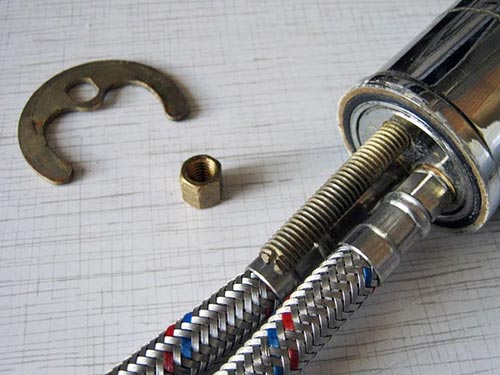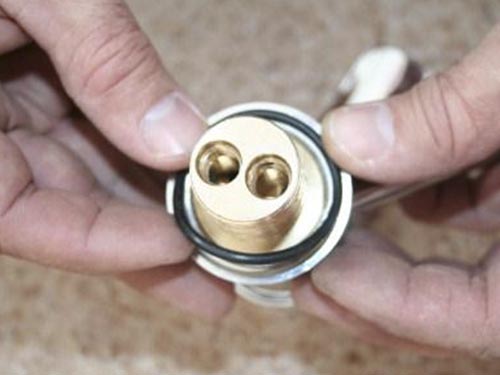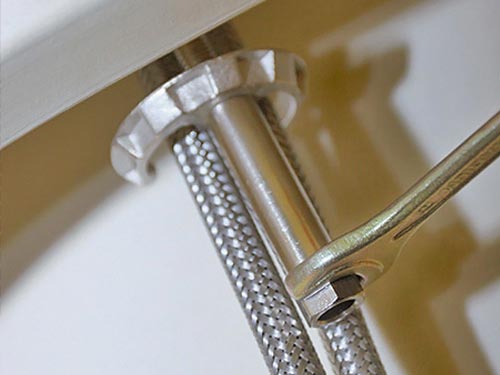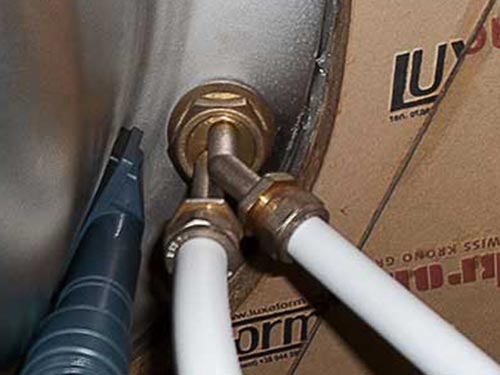Plumbing repairs for owners of houses and apartments cause constant headaches and loss of money due to periodic purchases of consumables and hiring a plumber.
And since the main problem is considered to be the process of restoring water pressure fittings and replacing plumbing fixtures, we will consider in detail how the self-installation of the faucet on the sink is carried out without the need to hire housing and communal services workers and extra cash costs.
Types of pipes for creating a flexible and rigid connection of the mixer with water fittings.
Depending on the quality of the required connection, the size of the sink, the power of the water pressure and the financial possibilities, three types of connecting pipes are offered for sale:
- Chrome Plated Copper Tube - Rigid and high quality connection using chrome plated copper or stainless steel tube. Installation requires high-precision and accurate bending, which takes a lot of time and effort, but in return, a high-quality and most durable connection is obtained with the possibility of being placed in a wall cavity or in concrete.
- Flexible bellows hose - (the cheapest and most accessible type of connection) stainless steel metal hose, without rubber inner inserts, but completely flexible due to the accordion-shaped tube. It is widely used to create a flexible connection of the mixer with water fittings.
- Metal-plastic heat-resistant pipe - allows you to create connections of medium hardness, but with the need to use additional adapter needles for a metal-plastic pipe and end switches with internal thread. This type of connection is used less often than others and only when absolutely necessary.

Check the complete set of the mixer before buying
A set of tools and materials
Since it is necessary to install the faucet on the sink with high accuracy and proper quality, for installation work it is necessary to prepare a standard set of tools for plumbing work:
- Large and small pliers.
- Adjustable and gas wrenches.
- Screwdrivers of different types and sizes.
- Hexagons.
- Open-end wrench 12×14 mm.
- Vinyl tape, MUV tape (Fluoroplastic Universal Material) or tow.
- Roulette.
You may need additional tools. Therefore, before buying and installing, you should study the installation instructions given by the manufacturer of your mixer and, based on these data, prepare an accurate set of tools and materials.
Preparing for the installation of the mixer
Before carrying out installation work, you should measure the distance between the water pressure fittings and the faucet fixed on the sink. To do this, you need to install it in a special socket of the sink and fix it slightly. Using a tape measure or measuring tape, measure the distance between the connecting hoses, the flexible faucet connection and the threads on the water pipe, taking into account all angles and future bends.
Note!
In any case, installing a faucet on a sink requires knowing the full distance between the components and further adding a small margin of length.
On average, you need to buy tubes or hoses 50-100 mm larger than the exact size for a more comfortable fit. If you have any doubts, then at retail outlets, specialists can advise and help you choose the material and length of the connecting pipes necessary for more accurate fixation.

The quality of the parts should not be in doubt
Mounting the faucet to the sink
The purchased faucet and its components must first be folded together in the order in which they will be attached to the sink. This way you can avoid silly mistakes during installation. The entire system of a standard faucet is assembled and installed on the sink in this order:
- With the help of special nuts and rubber gaskets, connecting tubes are screwed to the mixer and fixed in working position. For a tighter connection, you can wrap a little tow or muf tape on the thread.
- A rubber sealing ring is placed to the base of the mixer in a specially provided place (groove). It prevents water from leaking under the bottom of the sink.
- The tubes are passed into the hole in the sink, and the mixer is installed in the required working position.
- From the bottom of the sink, a gasket and a special crescent-shaped pressure pin are connected to the bottom of the faucet. After that, the final fixation of the entire system is carried out with a bolt and nut and the mixer is adjusted to the working position.
But in order for the installation of the faucet on the sink with your own hands to be complete and not lead to undesirable consequences, the entire system must be completely sealed and carefully fixed in the place intended for it. If the diameters of the connectors do not match, you need to install adapters or replace the mixer with a suitable one. Also, you can not overtighten or loosen the connections, you need to carefully tighten everything by hand and tighten it a little with a wrench or adjustable wrench.

Need to prepare a water supply
Pipeline preparation
Before starting work, the pipeline should be inspected for the presence of cracks and rust on the surface of the thread. In case of damage, appropriate restoration and repair work must be carried out. If the pipe diameter differs from the diameter of the mixer tubes, adapters are used for connection, which are sold in hardware stores and are selected in accordance with the required diameter.
To increase safety in the event of a mixer breakdown, a valve or valve is installed between the tubes and the pipeline for emergency water shut-off. It can be connected using a pipe thread and a valve, increasing the tightness with MUV tape or tow, winding it and fixing it in the required position. To check the tightness, you need to close the valve and open the water supply from the pipeline. In the case of a quality connection, you can proceed to the installation of the mixer.
Faucet installation with soft connection
Soft connection installations use a flexible bellows or rubber hose that bends easily and can be installed in places with sharp surface bends and where a hard connection cannot be applied. Since you need to install the mixer on the sink correctly and without errors, first connect the hoses to it and only after that connect them to the water pressure fittings - hot water to the left and cold water to the right. Both tubes are connected to the valves with union nuts and a sealant in the form of tow or muf tape, after which everything is tightened and the system is checked for leaks.

Fix the eyeliner
Rigid connection mounting
Metal-plastic and metal tubes are bent and adjusted before fixing the faucet to the sink. At the same time, they should be of suitable length, and the bends should be small and neat without sharp corners and distortions. As a result, the connections should not have excessive tension or pressure, this is fraught with consequences in the future.
Note!
There is a possibility of formation of microcracks in places of strong inflection and further complete destruction of the walls.
The finished tubes are connected to the mixer as indicated in the previously described method, and only after that the mixer is mounted to the sink. Upon completion, the tubes are connected to the water supply and the entire system is checked for leaks.
Many may doubt their strengths and capabilities, but if you take into account all the nuances and follow simple instructions, then the question of how to install a faucet on the sink with your own hands will not bring problems and difficulties, and the result will exceed any expectations.
